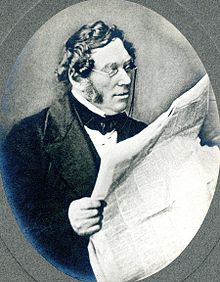Hugh Lee Pattinson
Hugh Lee Pattinson (born December 25, 1796 in Alston (Cumbria) , † November 11, 1858 in Newcastle-upon-Tyne ) was a British chemist and industrialist. He is known for the Pattinson process, named after him, for the separation of silver and lead .
life and work
Pattinson came from a Quaker family and his father was a shopkeeper in Alston. He became interested in chemistry at an early age and from around 1825 worked in a soap factory and as a coin validator.
Around 1829 he found the basis for his process for separating silver and lead by slow crystallization, but did not yet have enough money to develop it further and from 1831 worked as a supervisor in a lead factory. In 1834 he quit to start his own company. His process, which was more economical than the cupellation previously used , was patented in 1833 and made him wealthy. In 1850 he founded a chemical plant with his son-in-law Isaac Lowthian Bell and Robert Benson Bowman. Another son-in-law was the cable manufacturer Robert Stirling Newall (1812-1889).
He also invented a new white lead (lead oxychloride). Pattinson is also known for early daguerreotypes (around 1840).
In 1852 he became a Fellow of the Royal Society . After converting to the Anglican Church, he married Phoebe Walton in 1815 and had three daughters and three sons with her.
literature
- Winfried Pötsch u. a. Lexicon of important chemists , Harri Deutsch 1989
| personal data | |
|---|---|
| SURNAME | Pattinson, Hugh Lee |
| BRIEF DESCRIPTION | British chemist and industrialist |
| DATE OF BIRTH | December 25, 1796 |
| PLACE OF BIRTH | Alston (Cumbria) |
| DATE OF DEATH | November 11, 1858 |
| Place of death | Newcastle-upon-Tyne |

